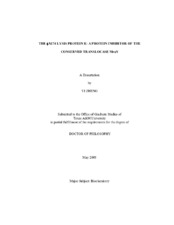| dc.description.abstract | Most bacteriophages release progeny virions at the end of the infection cycle by
lysis of the host. Large phages with double-stranded DNA genomes use a multigene
strategy based on holins, small membrane proteins, and bacteriolytic enzymes, or
endolysins. Holins mediate the control of endolysin activity and thus the timing of lysis.
Phages with small genomes only encode a single protein for cell lysis. There are three
known unrelated single protein lysis systems: the ?X174 E protein, the MS2 L protein,
and the Q? A2 protein. None of these phages encodes a cell wall degrading activity, and
previous work has shown that the lytic activity of E stems from its ability to inhibit the
host enzyme, MraY, which catalyzes the formation of lipid I, the first lipid intermediate
in cell wall synthesis.
The purpose of the work described in this dissertation was to characterize the
?X174 E-mediated inhibition of MraY using genetic and biochemical strategies. A
fundamental question was why no large phages use the single gene system. This was
addressed by constructing a recombinant phage, ?E, in which the holin-endolysin based
lysis cassette of ? was replaced with E. ?E was compared with ? in genetic and physiological experiments, with the results indicating that the holin-endolysin system
increases fitness in terms of adjusting lysis timing to environmental conditions. Using
?E, physiological experiments were conducted to characterize the interaction between E
and MraY in vivo. Transmembrane domains (TMD) 5 and 9 have been identified as the
potential E binding site by isolating MraY mutants resistant to E inhibition. The five Eresistant
MraY mutants were found to fall into three classes, which reflect the apparent
affinity of the mutant proteins for E. Finally, an assay for MraY activity employing the
dansylated UDP-MurNAc-pentapeptide and phytol-P, was used to demonstrate the
inhibition of MraY by purified E protein. It was determined that E is a non-competitive
inhibitor for MraY in respect with both substrates. A model for E-mediated inhibition of
MraY was proposed, in which E binds to TMDs 5 and 9 in MraY and thus inactivates
the enzyme by inducing a conformational change. | en |


